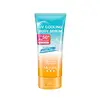What's inside
What's inside
 Key Ingredients
Key Ingredients

 Benefits
Benefits

 Concerns
Concerns

 Ingredients Side-by-side
Ingredients Side-by-side

Water
Skin ConditioningOctocrylene
UV AbsorberPropylene Glycol
HumectantEthylhexyl Salicylate
UV AbsorberButyl Methoxydibenzoylmethane
UV AbsorberDibutyl Adipate
EmollientC12-15 Alkyl Benzoate
AntimicrobialIsohexadecane
EmollientDiethylhexyl Butamido Triazone
UV AbsorberPhenoxyethanol
PreservativeGlyceryl Stearate
EmollientPEG-100 Stearate
Cetearyl Alcohol
EmollientPotassium Cetyl Phosphate
EmulsifyingTitanium Dioxide
Cosmetic ColorantPolyacrylamide
Menthol
MaskingSilica
AbrasiveC13-14 Isoparaffin
EmollientChlorphenesin
AntimicrobialSilica Dimethyl Silylate
EmollientXanthan Gum
EmulsifyingMethyl Diisopropyl Propionamide
MaskingDisodium EDTA
Acrylates/C10-30 Alkyl Acrylate Crosspolymer
Emulsion StabilisingNiacinamide
SmoothingAloe Barbadensis Leaf Juice
Skin ConditioningCucumis Sativus Juice
EmollientSodium Hydroxide
BufferingCarbomer
Emulsion StabilisingLaureth-7
EmulsifyingPotassium Sorbate
PreservativeBiosaccharide Gum-4
Skin ConditioningSodium Sulfite
PreservativeWater, Octocrylene, Propylene Glycol, Ethylhexyl Salicylate, Butyl Methoxydibenzoylmethane, Dibutyl Adipate, C12-15 Alkyl Benzoate, Isohexadecane, Diethylhexyl Butamido Triazone, Phenoxyethanol, Glyceryl Stearate, PEG-100 Stearate, Cetearyl Alcohol, Potassium Cetyl Phosphate, Titanium Dioxide, Polyacrylamide, Menthol, Silica, C13-14 Isoparaffin, Chlorphenesin, Silica Dimethyl Silylate, Xanthan Gum, Methyl Diisopropyl Propionamide, Disodium EDTA, Acrylates/C10-30 Alkyl Acrylate Crosspolymer, Niacinamide, Aloe Barbadensis Leaf Juice, Cucumis Sativus Juice, Sodium Hydroxide, Carbomer, Laureth-7, Potassium Sorbate, Biosaccharide Gum-4, Sodium Sulfite
Water
Skin ConditioningEthylhexyl Methoxycinnamate
UV AbsorberAlcohol Denat.
AntimicrobialButylene Glycol
HumectantSodium Hyaluronate
HumectantEthylhexyl Triazone
UV AbsorberTriethanolamine
BufferingXanthan Gum
EmulsifyingHydrolyzed Sodium Hyaluronate
Skin ConditioningSilica
AbrasivePolyglyceryl-10 Pentaisostearate
EmollientAcrylates/C10-30 Alkyl Acrylate Crosspolymer
Emulsion StabilisingHydrolyzed Collagen
EmollientGlycerin
HumectantSodium Acetylated Hyaluronate
HumectantDiethylamino Hydroxybenzoyl Hexyl Benzoate
UV FilterBis-Ethylhexyloxyphenol Methoxyphenyl Triazine
Skin ConditioningDisodium EDTA
Diethoxyethyl Succinate
SolventArginine
MaskingPolystyrene
Bis-PEG-18 Methyl Ether Dimethyl Silane
EmollientIsononyl Isononanoate
EmollientPhenoxyethanol
PreservativePolyvinyl Alcohol
Glycol Dimethacrylate Crosspolymer
Methylparaben
PreservativeHydroxypropyltrimonium Hyaluronate
Dipropylene Glycol
HumectantWater, Ethylhexyl Methoxycinnamate, Alcohol Denat., Butylene Glycol, Sodium Hyaluronate, Ethylhexyl Triazone, Triethanolamine, Xanthan Gum, Hydrolyzed Sodium Hyaluronate, Silica, Polyglyceryl-10 Pentaisostearate, Acrylates/C10-30 Alkyl Acrylate Crosspolymer, Hydrolyzed Collagen, Glycerin, Sodium Acetylated Hyaluronate, Diethylamino Hydroxybenzoyl Hexyl Benzoate, Bis-Ethylhexyloxyphenol Methoxyphenyl Triazine, Disodium EDTA, Diethoxyethyl Succinate, Arginine, Polystyrene, Bis-PEG-18 Methyl Ether Dimethyl Silane, Isononyl Isononanoate, Phenoxyethanol, Polyvinyl Alcohol, Glycol Dimethacrylate Crosspolymer, Methylparaben, Hydroxypropyltrimonium Hyaluronate, Dipropylene Glycol
 Reviews
Reviews

Ingredients Explained
These ingredients are found in both products.
Ingredients higher up in an ingredient list are typically present in a larger amount.
Acrylates/C10-30 Alkyl Acrylate Crosspolymer is a synthetic polymer. It is used to thicken and improve the texture of products. Due to its properties, it can prevent water and oil ingredients from separating.
Disodium EDTA plays a role in making products more stable by aiding other preservatives.
It is a chelating agent, meaning it neutralizes metal ions that may be found in a product.
Disodium EDTA is a salt of edetic acid and is found to be safe in cosmetic ingredients.
Learn more about Disodium EDTAPhenoxyethanol is a preservative that has germicide, antimicrobial, and aromatic properties. Studies show that phenoxyethanol can prevent microbial growth. By itself, it has a scent that is similar to that of a rose.
It's often used in formulations along with Caprylyl Glycol to preserve the shelf life of products.
Silica, also known as silicon dioxide, is a naturally occurring mineral. It is used as a fine, spherical, and porous powder in cosmetics.
Though it has exfoliant properties, the function of silica varies depending on the product.
The unique structure of silica enhances the spreadability and adds smoothness, making it a great texture enhancer.
It is also used as an active carrier, emulsifier, and mattifier due to its ability to absorb excess oil.
In some products, tiny microneedles called spicules are made from silica or hydrolyzed sponge. When you rub them in, they lightly polish away dead skin layers and enhance the penetration of active ingredients.
Learn more about SilicaWater. It's the most common cosmetic ingredient of all. You'll usually see it at the top of ingredient lists, meaning that it makes up the largest part of the product.
So why is it so popular? Water most often acts as a solvent - this means that it helps dissolve other ingredients into the formulation.
You'll also recognize water as that liquid we all need to stay alive. If you see this, drink a glass of water. Stay hydrated!
Learn more about WaterXanthan gum is used as a stabilizer and thickener within cosmetic products. It helps give products a sticky, thick feeling - preventing them from being too runny.
On the technical side of things, xanthan gum is a polysaccharide - a combination consisting of multiple sugar molecules bonded together.
Xanthan gum is a pretty common and great ingredient. It is a natural, non-toxic, non-irritating ingredient that is also commonly used in food products.
Learn more about Xanthan Gum